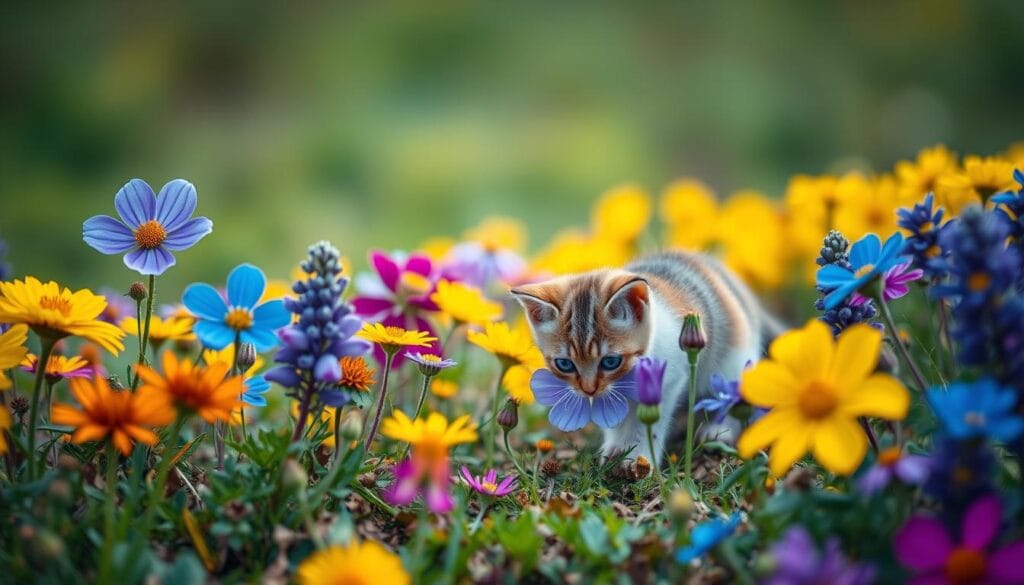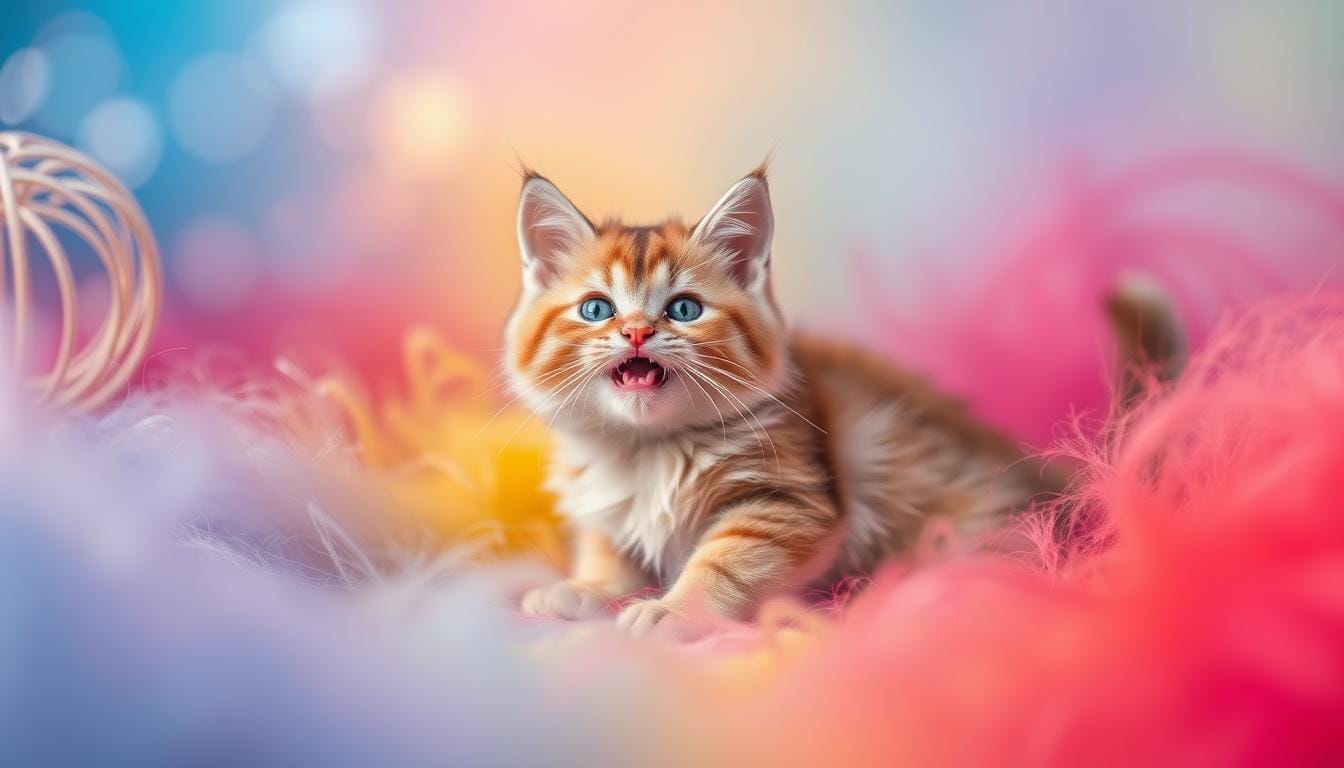What Colors Can Cats See? Unveiling the Truth About Feline Vision
Have you ever wondered what colors cats can see? Is their world duller than ours? The truth about cat color vision is fascinating. Cats see the world differently, focusing more on movement than color. This helps them hunt better in the dark.
Table of Contents
Exploring cat vision reveals their unique color perception. You’ll learn about the colors they see best, like blues and yellows. This knowledge will make you appreciate your cat’s special view of the world.
Key Takeaways
- Cats have limited color perception compared to humans, with a focus on blues and yellows.
- Can cats see color? Yes, but their color vision is more muted than humans.
- Cats prioritize movement detection over color perception, aiding their hunting instincts.
- What colors can cats see? Cats can see shades of blue and yellow more easily than other colors.
- Cat color vision is optimized for hunting in low-light conditions, not for vibrant color perception.
- Understanding cat color vision can help you choose the right toys and create a vision-friendly environment for your feline companion.
- Cats have fewer cones than humans, limiting their color perception and making them more sensitive to movement.
Understanding the Basics of Feline Vision
To understand what colors cats can see, we need to know about their vision basics. Cats have special eyes that help them see in the dark. Their eyes have parts like the cornea, iris, lens, and retina. These parts work together to focus light and see things.
Cats also have a special layer called the tapetum lucidum. It helps them see better at night by bouncing light back to their retina. This is key for their night hunting skills.
When we talk about what colors cats can see best, we see they are good at spotting movement. They can see blues, grays, and maybe yellows. This is similar to how some people see reds and greens.
The Structure of a Cat’s Eye
A cat’s eye has important parts like the cornea, iris, lens, and retina. The tapetum lucidum is also key for their night vision. This special setup helps them hunt well in the dark.
How Cats Process Visual Information
Cats see the world differently than humans. They have more rod cells for movement and less cone cells for color. This makes them great at catching prey in the dark.
When we look at what colors cats can see, we must think about how they see the world. This helps us understand their behavior.
Key Differences Between Cat and Human Eyes
Cats and humans have different eyes. Cats have a wider view, seeing 200 degrees compared to humans’ 180 degrees. They also need less light to see, needing only one-sixth of what humans do.
Knowing these differences helps us appreciate how cats see the world. It shows us what colors they can see best.
The Science Behind What Colors Can Cats See
Cats see colors differently because of their retina’s cones. They have L-cones and M-cones, which catch light in various ways. This helps them spot movement and changes in light better than a wide range of colors.
When thinking about what colors can cats see, remember they see blues and yellows better than other colors.
Studies show cats have fewer cone cells than humans. This means they see colors in muted tones like blues, yellows, greens, and greys. Reds and pinks look more like greens to them. This shows their color vision is not like ours.
Some important facts about cat color vision are:
- Cats see colors like a color-blind person might.
- They mainly see shades in grey, blue, and green.
- Cats are great at seeing grey colors, which helps them hunt.
Knowing what colors can cats see helps us choose better toys and settings for them. By understanding cat color vision, we can appreciate their unique view of the world more.
Color Receptors in Cat Eyes: Cones and Rods
Understanding what colors cats can see best starts with knowing their color receptors. Cats have two types of cones and many rods in their eyes. These cones help them see colors and are sensitive to light wavelengths.
So, what colors can cats see? They can see about 10,000 shades, mostly in gray, blue, and yellow. This is because their eyes are great at detecting movement and changes in brightness, even in low light.
To figure out what colors cats can see, we need to look at their cone cells. There are two types of cones in cat eyes. One type sees green and blue, while the other sees red and yellow. But, cats struggle to see red, orange, and green, which is key to their color vision.
Types of Cone Cells in Feline Eyes
Cats have two types of cone cells. These cells are sensitive to different light wavelengths. This lets them see a variety of colors, but not as vividly as humans.
- Sensitive to medium wavelengths, such as green and blue
- Sensitive to long wavelengths, such as red and yellow
The Role of Rod Cells in Night Vision
The many rods in a cat’s retina help them see in the dark. This is crucial for hunting at dawn and dusk. The rods are very sensitive to low light and help cats detect movement and changes in brightness.
The Color Spectrum Through Your Cat’s Eyes
Have you ever wondered what colors cats can see? Their eyes are made to spot movement and changes in light. Cats can see colors like yellow, gray, and blue, and maybe different shades of green.
Cats see best in blue-violet and yellow-green light. But they can’t see red-orange light because they lack a third color receptor. This means their color vision is narrower than ours. Your cat might see colors in a softer, more pastel way, with blues and yellows standing out.
Some important facts about cat vision are:
- Cats can see in much dimmer light than humans.
- They are great at spotting small changes in gray shades, which helps them hunt in the dark.
- Cats can see blue, green, and yellow well, but struggle with red and orange.

So, can cats see color? Yes, but differently than humans. Knowing what colors cats can see helps us connect better with them. For instance, toys in blue, green, or yellow are more visible and fun for them.
Common Myths About Cat Vision Debunked
Many myths about cat vision have been proven wrong by science. You might think cats see only in black and white. But, they actually see blues and yellows more clearly. This is because they have only two types of cone cells in their eyes, leading to dichromatic vision.
Another myth is that cats can see in complete darkness. This is not true. Cats can see well in low light, but they still need some light. The tapetum lucidum in their eyes helps them see better at night by reflecting light. This lets them hunt at dawn and dusk, when it’s not too bright.
Debunking Color Blindness Myths
Cats are not color blind like humans think. They can see blues and yellows but struggle with reds and greens. These colors might look like shades of gray to them. They can see blues, greens, and yellows, with blue being the most vivid. This helps them spot prey in the dark, which is key for their cat color vision.
Knowing what colors cats can see best is important for cat owners. It helps them pick toys and accessories that match their cat’s vision. This knowledge also shows how important good lighting is at home. Cats use their vision to move around and play, which is linked to what colors can cats see.
How Cat Vision Evolved: An Evolutionary Perspective
Exploring cat vision reveals how their eyes have changed over time. Their vision evolved to help them hunt and survive. Cats can spot movement and changes in light, key for hunting and staying safe.
When we look at what colors can cats see, we see their vision is perfect for hunting. They can see shades of grey, blue, and green. But they can’t see red, brown, or orange.
Survival Advantages of Feline Vision
Cats’ vision helps them survive by spotting even the smallest movements. They see motion well, but not slow or still things. This skill helps them catch prey and stay safe.

Adaptation to Different Light Conditions
Cats are great at hunting in the dark. They’re most active at dawn and dusk, when it’s light enough. Their big, changing pupils help them see in different lights. Understanding can cats see color and what color can cats see shows their vision is perfect for their lifestyle.
Which Colors Can Cats See Best?
Ever wonder what colors cats see best? Research shows cats see blues and yellows better than other colors. This helps them in their natural environment and lifestyle. Their limited color vision focuses on detecting movement and changes in brightness, not a wide range of colors.
When thinking about what colors can a cat see, it’s key to know they can spot shades in grey, blue, and green. They’re great at seeing different shades of grey, which helps them find prey. But, they struggle to tell purple, yellow, and white apart. They also can’t see red, brown, or orange.
Here are some important points about what colors can cats see best:
- Cats can see about 10,000 shades of color, mostly grey, blue, and yellow.
- They have fewer cones than rods in their eyes, making their vision better in low light.
- Cats are better at spotting motion, which is key for hunting in low light, like dawn and dusk.
Understanding cat color vision and what colors can cats see best helps us see the world through their eyes. By knowing how important blues and yellows are to them, we can make their world more interesting and fun.
The Impact of Color Vision on Cat Behavior
Exploring feline vision shows how color affects cat behavior. Cats use their limited color vision to spot movement and brightness changes. This is key for hunting and staying safe. They often prefer blue or yellow toys and settings.
Cats are most sensitive to blue and yellow, which shows in their toy choices. They have two types of cone cells for these colors. Seeing these colors helps them find prey and move around.
Color vision greatly impacts cat behavior. For instance, cats use it to:
- Detect movement and changes in brightness, which is essential for hunting and self-defense
- Prefer toys and environments that are blue or yellow in color
- Navigate their surroundings and detect prey
Knowing what colors cats see helps you interact better with them. By understanding their limited color vision, you can create a more engaging space. Remember, cats see blue and yellow but not red or green. This affects how you should interact with them.
Comparing Cat Vision to Other Animals
Understanding cat color vision is fascinating when compared to other animals, like dogs. You might ask what colors can dogs see and how their vision compares to cats. Dogs can see blues and yellows better because they have two types of cones sensitive to different light wavelengths.
What colors can cats see is also limited, with cats struggling to see reds and greens. Cats have more rod cells, which helps them see better in the dark. Here are some key differences between cat and dog vision:
- Dogs have a field of vision of 240 degrees, while cats have a field of vision of 200 degrees.
- Cats have more rod cells than humans, enhancing their ability to see in low light.
- Dogs can see objects clearly at 20 feet that a human with normal vision can see at 75 feet.
Understanding cat color vision and how it compares to other animals can help you appreciate your cat’s unique view of the world. By recognizing the limitations and advantages of your cat’s vision, you can make their environment more engaging and stimulating.
Practical Tips for Cat Owners Based on Feline Vision
As a cat owner, knowing what colors cats can see is key. Cats see blues and greens well, which helps when picking toys and setting up their space. This knowledge makes their environment more fun and safe.
When picking toys, choose blue or yellow ones. These colors are easier for cats to see. Also, toys with different textures and patterns can excite their touch and sight.
Creating a safe and fun space is also important. Offer various scratching posts and climbing spots. These help your cat exercise and see their surroundings better. Knowing how cats see helps you make their space better for them.
Creating a Vision-Friendly Environment
- Provide a range of scratching posts and climbing structures
- Choose toys that are blue or yellow in color
- Use toys with different textures and patterns to stimulate your cat’s sense of touch and vision
By following these tips, you can make a space that’s great for your cat. It will help their vision and overall happiness. Remember, cats see colors differently, so tailoring their space to their needs is important.
Conclusion: Understanding Your Cat’s Colorful World
Cats see the world differently than we do. They don’t see colors as brightly as humans, but they’re amazing hunters. Their eyes are made for low light and they can spot movement easily.
Knowing what colors cats can see helps you make their world better. You can pick toys in colors they love or design a space that’s easy for them to get around. This makes life better for both you and your cat.
Enjoy the special way your cat sees the world. It’s colorful and unique. Celebrate how they experience their surroundings.
FAQ
What is the structure of a cat’s eye?
A cat’s eye has several parts. These include the cornea, iris, lens, and retina. They work together to focus light and detect visual information. Cats also have a reflective layer called the tapetum lucidum, which helps their night vision.
How do cats process visual information?
Cats see colors differently than humans. They can see blues and yellows better. This is because their retina has specific cones that detect different light wavelengths.
What are the key differences between cat and human eyes?
Cats have more rods in their retina than humans. This lets them see better in the dark and spot small movements. They also see colors differently, often like humans do at dusk or dawn.
What types of cone cells do cats have in their eyes?
Cats have two types of cones: L-cones and M-cones. L-cones detect red and yellow light, while M-cones detect green and blue.
What is the role of rod cells in cat vision?
The rods in a cat’s eye help them see in low light. This is key for their hunting at night. Their many rods let them spot even slight movements in the dark.
What colors can cats see best?
Cats see blues and yellows better than other colors. This helps them in their environment and lifestyle. Their limited color vision is good for detecting movement and changes in brightness.
Is it true that cats only see in black and white?
No, this is a myth. Cats don’t see in black and white. Instead, they see a limited range of colors, with blues and yellows being more prominent.
Can cats see in complete darkness?
No, this is another myth. Cats can’t see in complete darkness. They need some light to see. Their ability to see in low light is due to their many rods, which are sensitive to low light levels.
Are cats color blind?
No, cats are not color blind in the classical sense. They can see colors, but their vision is limited. They see blues and yellows better than other colors, due to their cone structure and sensitivity to light wavelengths.
How has cat vision evolved over time?
Cat vision has evolved to help them hunt and survive. Their ability to detect movement and changes in brightness is crucial. This adaptation has helped them thrive in different light conditions and their nocturnal lifestyle.
How does cat color vision affect their behavior?
Cat color vision greatly affects their behavior, like hunting and play. They use their limited color vision to detect movement and changes in brightness. This is essential for hunting and self-defense. Their color preferences for toys and environments also reflect their visual abilities.
How does cat vision compare to other animals, like dogs?
Cat vision is similar to dog vision. Both have limited color vision and see blues and yellows better. The similarities and differences in their vision are shaped by their evolution, environment, and lifestyle.
How can cat owners create a vision-friendly environment for their feline friends?
Cat owners can create a safe and stimulating environment for their cats. Choose toys that are blue or yellow. Provide various activities and spaces that cater to their limited color vision and need for detecting movement and changes in brightness.
There are no reviews yet. Be the first one to write one.







